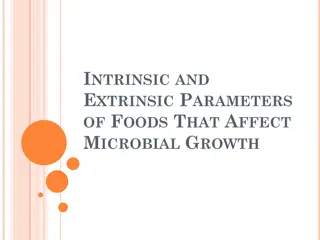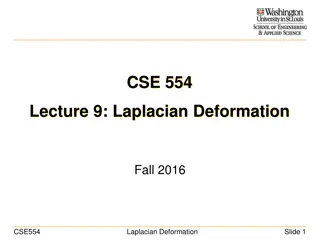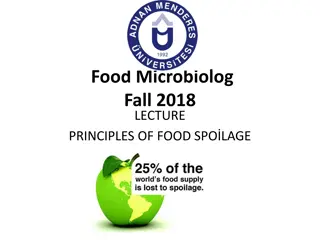Factors Affecting Microbial Growth in Food: Intrinsic and Extrinsic Factors
In food, microbial growth is influenced by intrinsic factors like pH, water activity, nutrient content, and extrinsic factors such as environmental conditions. The pH level, moisture content, and water activity play crucial roles in determining the growth of microorganisms, with specific ranges affecting different types of bacteria, molds, and yeasts. Understanding these factors is essential for food safety and preservation.
Download Presentation

Please find below an Image/Link to download the presentation.
The content on the website is provided AS IS for your information and personal use only. It may not be sold, licensed, or shared on other websites without obtaining consent from the author.If you encounter any issues during the download, it is possible that the publisher has removed the file from their server.
You are allowed to download the files provided on this website for personal or commercial use, subject to the condition that they are used lawfully. All files are the property of their respective owners.
The content on the website is provided AS IS for your information and personal use only. It may not be sold, licensed, or shared on other websites without obtaining consent from the author.
E N D
Presentation Transcript
Factors affecting microbial growth in food (a) Intrinsic factors: These are inherent in the food. They include: pH, water activity, oxidation reduction potential, nutrient content, antimicrobial contents, biological structure (b) Extrinsic factors: Are factors external to the food that affect microbial growth.
Factors affecting microbial growth in food (a)Intrinsic factors: These are inherent in the food. They include: Hydrogen ion concentration (pH) Moisture content Nutrient content of the food Antimicrobial substances Biological structures
1. Hydrogen ion concentration (pH) Most bacteria grow best at neutral or weakly alkaline pH usually between 6.8 and 7.5. Some bacteria can grow within a narrow pH range of 4.5 and 9.0, e.g. Salmonella Other microorganisms especially yeasts and molds and some bacteria grow within a wide pH range, e.g. molds grow between 1.5 to 11.0, while yeasts grow between 1.5 and 8.5.
pH values of some food products Food type Beef Chicken Milk Cheese Fish Oyster Fruits Vegetables Range of pH values 5.1 - 6.2 6.2 6.4 6.3 6.8 4.9 - 5.9 6.6 - 6.8 4.8 - 6.3 < 4.5 (most < 3.5) 3.0 6.1
Microorganisms that are able to grow in acid environment are called acidophilic microorganisms. These microorganisms are able to grow at pH of around 2.0 Yeasts and molds grow under acidic conditions. Other microorganisms such as Vibrio cholerae are sensitive to acids and prefer alkaline conditions. Most bacteria are killed in strong acid or strong alkaline environment except Mycobacteria.
Minimum and maximum pH for growth of some specific microorganism Microorganism Minimum Maximum Escherichia coli 4.4 9.0 Salmonella enterica serovar typhi 4.5 8.8 All bacteria 4.0 9.0 Molds 1.5 11.0 Yeast 1.5 8.5
2. Moisture content The effect of moisture is in terms of water activity: -the amount of free water in a food medium. The amount of free water is important for growth of microorganisms. If there is lack of free water microorganisms will not grow. Water activity is defined as the vapour pressure of a food substance to that of water at the same temperature. (Aw = VPFood/VPWater)
Moisture content The water activity of pure water is equal to 1.0 Food products have a water activity of less than 1.0. A saturated salt solution has a water activity of 0.75. Salting and drying reduces the water activity of a food product.
Water activity of some food products Food Product Water activity Raw meat and milk 0.99- 1.0 Luncheon meat 0.95 Boiled ham, sliced bacon 0.90 Dried grains 0.80
Water activity levels Growth of microorganisms is greatly affected by the level of water activity (Aw) in the food. Inhibition of growth occurs if the water activity for food is lowered beyond an organism s minimum level of water activity that is necessary for growth. Microorganisms have varying minimum water activity requirements that supports their growth in food.
Minimum water activity that supports growth of some microorganisms Microorganism Water activity Clostridium botulinum, Bacillus cereus, Pseudomonas aeruginosa, Salmonella spp. Staphylococcus aureus (anaerobic), Candida spp., Saccharomyces Staphylococcus aureus (aerobic) Penicillium spp. Most spoilage yeast Most spoilage molds Osmotic yeast 0.95 0.95 0.95 0.95 0.90 0.86 0.82 0.88 0.80 0.70
3. Nutrients content of the food Microorganisms require proteins, carbohydrates, lipids, water, energy, nitrogen, sulphur, phosphorus, vitamins, and minerals for growth. Various foods have specific nutrients that help in microbial growth. Foods such as milk, meat and eggs contain a number of nutrients that are required by microorganisms. These foods are hence susceptible to microbial spoilage.
Antimicrobial substances Antimicrobial substances in food inhibit microbial growth. Various foods have inherent antimicrobial substances that prevent (inhibit) microbial attack. Such inhibitors are like lactenin and anti- coliform factors in milk and lysozyme in eggs.
Biological structures Some foods have biological structures that prevent microbial entry. For example, meat has fascia, skin and other membranes that prevent microbial entry. Eggs have shell and inner membranes that prevent yolk and egg white from infection.
(b) Extrinsic factors are factors external to the food that affect microbial growth. They include: 1. Temperature of storage, 2. Presence and concentration of gases in the environment 3. Relative humidity of food storage environment.
1. Temperature The growth of microorganisms is affected by the environmental temperatures. Various microorganisms are able to grow at certain temperatures and not others. Bacteria can therefore be divided into the following groups depending upon their optimum tmperature of growth.
(i). Psychrophilic microorganisms These grow best at about 20oC but also down to -10oC in unfrozen media. Psychrophilic bacteria can cause food spoilage at low temperatures. Several of the microorganisms found in the soil and water belong to this group.
(ii). Mesophilic bacteria These organisms grow between 25oC and 40oC, with an optimum growth temperature close to 37oC Some such as Pseudomonas aeruginosa may grow at even lower temperatures between 5- 43oC None of the mesophilic bacteria are able to grow below 5oC or above 45oC. Most pathogenic bacteria belong to this group.
(ii). Thermophilic bacteria. These grow at temperatures above 45oC. Often their optimum growth temperatures are between 50oC and 70oC. Growth of some bacteria occur at 80oC. Bacteria in this group are mainly spore formers and are of importance in the food industry especially in processed foods.
Note that: The effect of temperature on microbial growth also depends upon other environmental conditions such as: o Growth factors in the nutrient medium, opH of the food, and oWater activity.
2. Concentration of gases in the environment This relates to the presence and concentration of gases in the food environment. Various microorganisms require for growth, either high oxygen tension (aerobic), low oxygen tension (microaerobic) or absence of oxygen (anaerobic). Some microorganisms may grow either in high oxygen tension, or in the absence of oxygen (facultative anaerobes).
Foods affected by various groups Anaerobic or facultatively anaerobic sporeformers are most likely to grow in canned foods . Microaerophilic bacteria are most likely to grow in vacuum packed foods since they have low oxygen tension, while Aerobic bacteria are likely to grow on the surface of raw meat. Aerobic molds will grow in insufficiently dried or salted products
3. Relative humidity Relative humidiy is the amount of moisture in the atmosphere or food environment. Foods with low water activity placed at high humidity environment take up water, increase their water activity and get spoiled easily. For example, dry grains stored in a environment with high humidity will take up water and undergo mold spoilage.





















